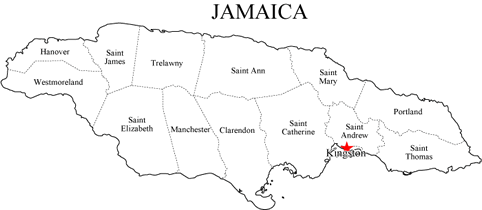Jamaica's History

Information on Jamaica
Jamaica is an island nation of the Greater Antilles, 234 kilometres (145 miles) in length and as much as 80 kilometres (50 miles) in width, 10,990 square kilometres (4,243 sq miles).
Jamaica was inhabited by Arawak Indians when Columbus explored it in 1494. It remained under Spanish rule until 1655, when it became a British colony. Buccaneers operated from Port Royal, also the capital, until part of it fell into the sea as a result of an earthquake in 1692.
Black slaves were imported from the west coast of Africa to work on the sugar plantations. With the abolition of slave trade in 1807 and emancipation of the slaves in 1833. On May 5, 1953, Jamaica gained internal autonomy, in 1958 it led to the organization of the West Indies Federation. Sir Alexander Bustamente later campaigned to withdraw from the federation. Jamaica became independent on Aug. 6, 1962.
With 2.8 million people, it is the third most populous anglophone country in the Americas, after the United States and Canada. It remains a Commonwealth realm with Queen Elizabeth II as head of state. Kingston is the country's largest city and the capital.
Out of all the British colonies in the Caribbean, Spanish Town has the oldest Cathedral. The Spanish were forcibly evicted by the English at Ocho Rios in St. Ann, In 1655 the English, lead by William Penn and General Robert Venables, took over the last Spanish fort in Jamaica. The name of Montego Bay, the capital of the parish of St. James, was derived from the Spanish name manteca bahia (or Bay of Lard) for the large quantity of boar used for the lard-making industry.
Parishes of Jamaica
Jamaica is divided into fourteen Parishes (Counties). Parishes have been a feature of local administration in Jamaica ever since the island was captured by the English in 1655. Throughout its history, Jamaica has had a number of parishes, some of which no longer exist. In 1865, Jamaica once had 22 parishes. The current order of parishes was established in 1867.
Parish
Clarendon
Hanover
Kingston
Manchester
Portland
Saint Andrew
Saint Ann
Saint Catherine
Saint Elizabeth
Saint James
Saint Mary
Saint Thomas
Trelawny
Westmoreland
Capital
May Pen
Lucea
Kingston
Mandeville
Port Antonio
Half Way Tree
Saint Anns Bay
Spanish Town
Black River
Montego Bay
Port Maria
Morant Bay
Falmouth
Savanna-la-Mar
Jamaica Economy
The Jamaican economy is heavily dependent on the service sector (mainly tourism). Most of the country foreign exchange is derived from tourism, agricultural export (sugar, banana etc.), remittances and bauxite/alumina mining. The discovery of bauxite in the 1940s and the subsequent establishment of the bauxite-alumina industry shifted Jamaica's economy from sugar and bananas. The Jamaican economy suffers from serious debt, high inflation and uneven growth rates.
The Arawak Indians
Jamaica was originally inhabited by the Arawak Indians and possible the Taino from South America. The Arawak Indians were a gentle peace loving farming and fishing race. They survive mainly on a diet of maze, cassava, vegetables and fish. They grew cassava (yaca) and maize which were their main staple food which flourish in the humid, wet tropical climate.
Christopher Columbus
Christopher Columbus was born in 1451 and died in 1506. Christopher Columbus was born in the Italian seaport of Genoa in 1451, to a family of wool weavers. He became an experienced sailor and moved to Lisbon in Portugal. He tried for many years to persuade kings and queens to give him money for food and ships so he could find a new route to China. Columbus persuaded King Ferdinand and Queen Isabella of Spain to give him the money.